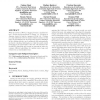1091 search results - page 85 / 219 » Swarming to rank for information retrieval |
CIKM
2010
Springer
13 years 7 months ago
2010
Springer
Traditional interactive information retrieval systems function by creating inverted lists, or term indexes. For every term in the vocabulary, a list is created that contains the d...
HT
2009
ACM
14 years 10 days ago
2009
ACM
With the advent of Web 2.0 tagging became a popular feature. People tag diverse kinds of content, e.g. products at Amazon, music at Last.fm, images at Flickr, etc. Clicking on a t...
SIGIR
2005
ACM
14 years 2 months ago
2005
ACM
Link analysis algorithms have been extensively used in Web information retrieval. However, current link analysis algorithms generally work on a flat link graph, ignoring the hiera...
WWW
2005
ACM
14 years 9 months ago
2005
ACM
We present the design of Dynabot, a guided Deep Web discovery system. Dynabot's modular architecture supports focused crawling of the Deep Web with an emphasis on matching, p...
CORR
2010
Springer
13 years 9 months ago
2010
Springer
Abstract. The Library of Babel, described by Jorge Luis Borges, stores an enormous amount of information. The Library exists ab aeterno. Wikipedia, a free online encyclopaedia, bec...

